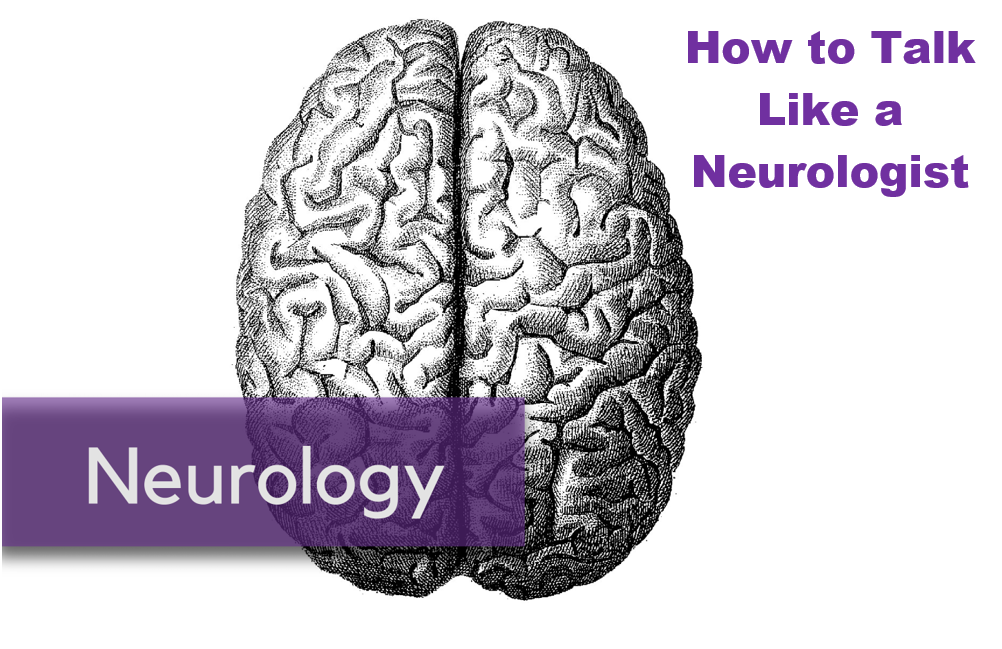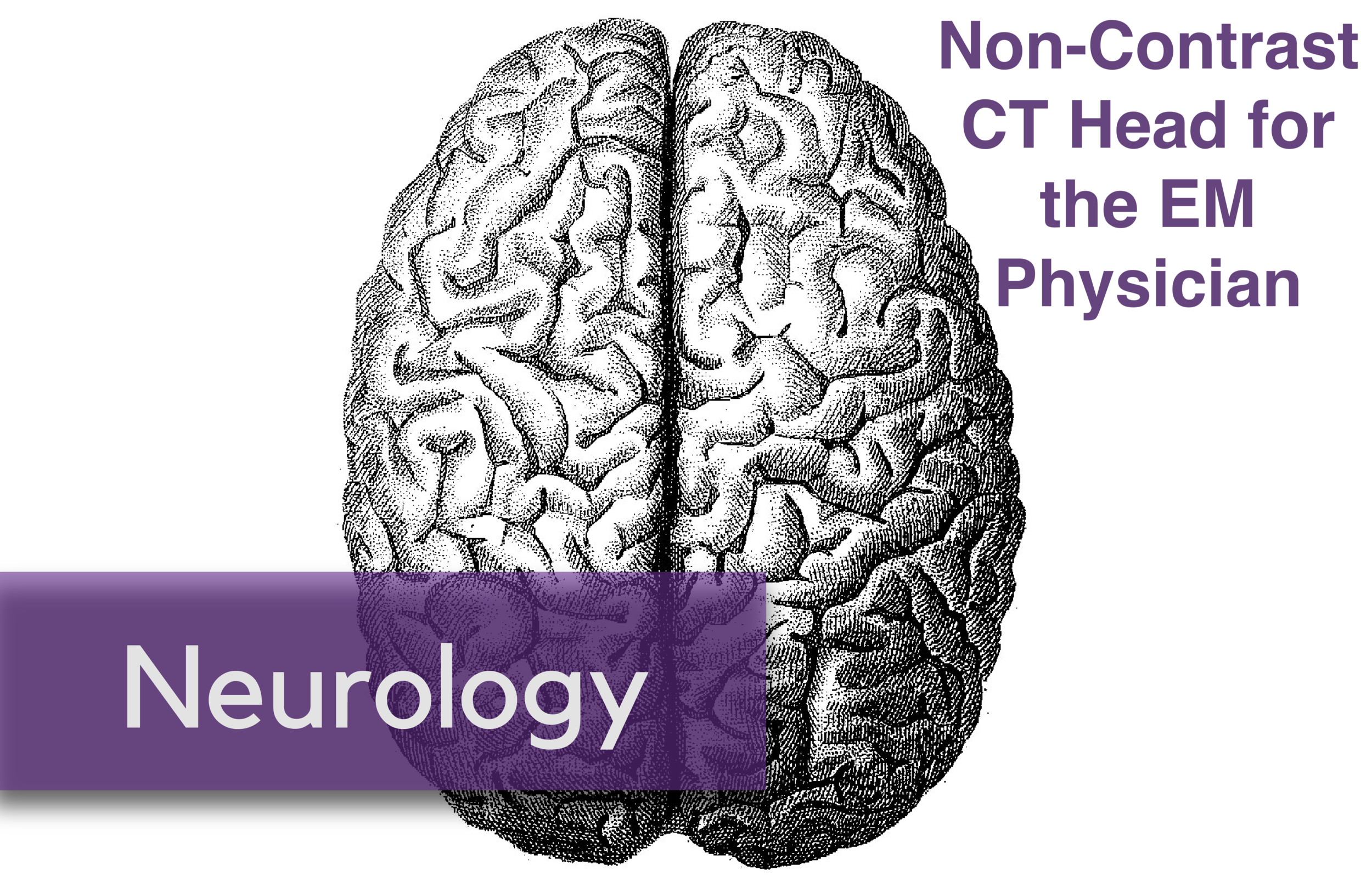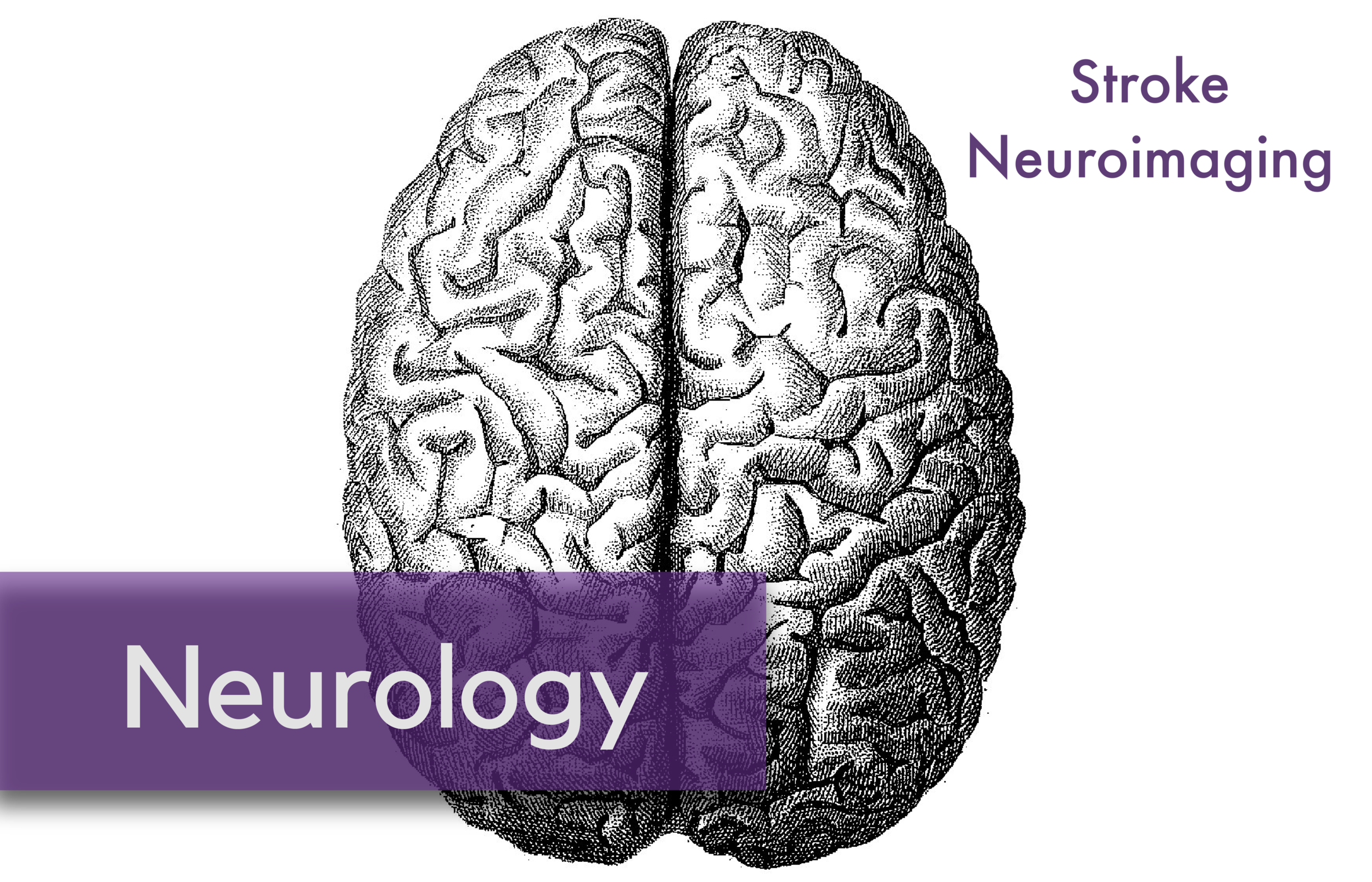Written by: Justin Seltzer, MD (NUEM PGY-1) Edited by: Andrew Cunningham, MD, (NUEM PGY-3) Expert commentary by: David Rusinak, MD
Neuroimaging, mainly using CT, has become an indispensable part of our emergency diagnostic process, but, all too often we rely on radiologists to interpret what we ordered. The goal of this multi-part blog is as follows:
To cover the basics of how to look at a CT brain and quickly identify life threat
Review the literature supporting the major ED indications
Discuss special considerations, such as when to use contrast, angiography, or MRI instead.
Systematic Reading of a CT Brain
The first portion of this blog will focus on how to read a CT brain quickly with a focus on life threats.
The classic mnemonic, “Blood Can Be Very Bad,” is a pathology oriented, step-wise method to look for blood, cistern changes, and alterations to the brain parenchyma, ventricle appearance, and bony anatomy. Applying this approach to each image cut individually can help reveal subtle findings that would otherwise be easily missed by quick scrolling.
Blood:
Blood can collect both intra-axially (parenchymal) and extra-axially (outside the parenchyma).
Figure 1
Classically, spontaneous intra-axial bleeding originates in deep structures such as the basal ganglia and thalamus (Figure 1).
In the setting of trauma, intra-axial bleeding is often ipsilateral or directly contralateral to the injury site (coup-contrecoup) but can be anywhere
Inferior frontal and anterior temporal lobes are high risk for traumatic contusions due to close proximity to bone (Figure 2)
Figure 2
Extra-axial bleeding is defined by location: mainly subdural, epidural, subarachnoid, and intraventricular hemorrhages. The patterns for these are well known and readily identified, however below are some key points on extra-axial bleeding.
Finding chronic subdural hematomas can be difficult as older blood and grey matter are similar appearing
Mass effect, abnormal appearing brain folds on that side, and use of coronal reconstructions can help identify
Subarachnoid hemorrhage becomes difficult to see within hours to days but acutely is often observed well in the cisterns (see below)
Be careful not to mistake choroid or pineal calcifications for hemorrhage
Don’t forget about scalp hematomas
Cisterns:
The cisterns are not ventricles but rather outpouchings of the subarachnoid space. When evaluating a CT brain the following, certain cisterns have clinical relevance for potential herniation syndromes, layering of subarachnoid blood, and/or the significant structures that run through them. Figures 3-5 show the locations of the major cisterns described below.
Figure 3
Figure 4
Suprasellar: Located in the area of the sella turcica, forms a pentagon/star shape
Classic location of subarachnoid hemorrhage due to proximity to circle of Willis
Obliteration associated with downward transtentorial (i.e. uncal) herniation or due to severe elevated ICP
Perimesencephalic cistern: A group of interconnected basal cisterns surrounding the midbrain (mesencephalon), important location of subarachnoid hemorrhage, may see effacement (reduction or loss) with tonsillar herniation
Interpeduncular: Located in the area of the cerebral peduncles
Quadrigeminal: Classically forms a W shape, obliteration associated with upward herniation
Ambient and crural: Connections between quadrigeminal and interpeduncular cisterns
Cerebellopontine: Located between anterior cerebellum and lateral pons, synonymous with area of cerebellopontine angle
Cisterna magna: Located between the cerebellum and medulla, receives fourth ventricular CSF outflow (Figure 4)
Prepontine: Located at the anterior aspect of the pons
Figure 5
Brain parenchyma:
CT allows for gross evaluation of the major structures as well as a differentiation of grey and white matter by Hounsfield units. The focus here is major parenchymal disruptions.
Mass lesions, mass effect, midline shift: Because of the fixed nature of the skull, mass lesions of any type easily exert pressure on the surrounding tissue (mass effect) that can result in increased ICP, midline shift, and herniation.
Midline shift is measured in millimeters of displacement of the septum pellucidum at the level of the foramen of Monro from the midline of the skull
Ischemic changes: depending on the size of the involved territory and duration, may be subtle or obvious density or architectural changes.
Early signs of infarction: reduced grey-white matter distinction and loss of insular hyperdensity
Ventricles:
The ventricular system is where CSF is produced and the route by which it travels into the subarachnoid space. The lateral ventricles drain via the foramina of Monro to the third ventricle, which then drains via the cerebral aqueduct (aqueduct of Sylvius) to the fourth ventricle and then to the cisterna magna and the rest of the subarachnoid space via the median and lateral apertures (foramina of Magendie and Lushka, respectively). Figures 3-5 also show the locations of the major ventricles.
Interruption of ventricular CSF flow will cause proximal ventricular dilation that helps localize the level of obstruction
If unsure between hydrocephalus and atrophy, dilation of temporal horns of the lateral ventricles can be helpful as it occurs in hydrocephalus involving the lateral ventricles but not with hydrocephalus ex vacuo
Bones:
Intimate knowledge of bony anatomy is not essential fracture evaluation. However, it is crucial that the bony anatomy be viewed with a dedicated bone window. Skull and facial fractures can be subtle and the presence of blood, especially an epidural hematoma, may help localize them. As noted above, soft tissue findings such as scalp hematomas are important to rule out as well.
Key Learning Points and Conclusions
A systematic approach is essential to avoid missing significant findings, especially with complex neuroimaging—remember “Blood Can Be Very Bad”
Immediately look for: blood anywhere (don’t forget the scalp!), effacement of major cisterns, mass effect/midline shift, enlarged ventricles (temporal horns), skull fractures
Older blood, such as a chronic subdural hematoma, can be hard to find and may require different cuts or inference from mass effect or effaced sulci
Signs of infarction may be subtle (more on this later)
In the next installation, we will discuss the major indications for CT brain and the utility of CT for these indications.
Expert Commentary
Overall, this is a very nice approach to head CT interpretation. The classic mnemonic, “Blood Can Be Very Bad,” is not something I’ve heard of before, but it works. Let’s take each search item in turn.
Blood
A helpful way to think about intracranial hemorrhage is to consider the causes of hemorrhage and the most common location for each pathology. Common causes include trauma, stroke (hypertensive or hemorrhagic conversion of a venous or arterial infarct), neoplasm (primary or secondary), vascular (aneurysm, AVM, dural AV fistula), and spontaneous (anticoagulation, amyloid angiopathy, vasculitis). If you consider the location of each of these pathologies, the hemorrhage will typically be primarily in this location. A tumor, for example, will cause a parenchymal bleed, a ruptured aneurysm will cause subarachnoid hemorrhage, an AVM will result in a parenchymal bleed, etc. Often with parenchymal bleeds additional imaging, vascular and MRI, as well as follow up imaging will be necessary to determine the underlying cause.
A correction is that subacute hemorrhage, not chronic, has a density similar to gray matter. Chronic subdural hemorrhages are usually very hypodense and easy to detect on CT. So, from a practical perspective, a patient experiencing headaches from subarachnoid hemorrhage that is greater than 3 or 4 days old may be occult by CT. This underscores the role of lumbar puncture and vascular imaging in working up patients with headaches.
Another important concept to keep in mind is window and level when interpreting CTs. Different substances (air, metal, bone, blood, fat, etc) have different and defined densities. The pathologies associated with each of these substances (fractures, edema in the setting of stroke, etc) can be better seen by adjusting the window and level settings. This can be done manually or, typically, PACS viewers have preset brain, bone, lung and soft tissue windows that can be displayed by pressing different numbers on the keypad. Subtle subdural hemorrhages are often only seen with the appropriate window and level that allows distinction of the hemorrhage from the overlying calvarium.
Cisterns
The blood vessels course through the cisterns, so these must be scrutinized for the presence of hemorrhage secondary to a ruptured aneurysm in a patient presenting with an atraumatic headache. The cisterns are also effaced in the setting of mass effect. Mass effect may be from a space occupying lesion; such as a tumor, abscess, or hemorrhage; or from diffuse cerebral edema with generalized brain swelling. Often the absence of something (i.e. patent basal cisterns) can be harder to detect than the presence of something, like hemorrhage. It is, therefore, important to examine the basal cisterns on each case to get comfortable with their normal variation of appearance so that their absence, such as in diffuse cerebral edema, is not missed.
Brain parenchyma
Subtle changes in parenchymal density can be difficult to detect. It is important to get acquainted with ideal window and level settings to uncover subtle parenchymal changes. Also comparison with prior imaging, if available, is necessary to determine the chronicity of parenchymal findings. Understanding where a physical exam finding localizes intracranially can also be very useful- aphasia or left upper extremity weakness localize to very different locations, for example. Lastly, always look at the vessels in the subarachnoid space to identify hyperdense thrombus in the setting of a suspected stroke.
Ventricles
Distinguishing volume loss from ventricular dilatation takes experience to understand the variation of normal across the entire age spectrum. If hydrocephalus is suspected, determining if it is obstructive or communicating can help to understand the underlying cause. The temporal horns are the most elastic portion of the ventricles and dilate first in the setting of hydrocephalus.
Bones
Depressed skull fractures and easy to see on routine bone windows. Things get complicated when subtle non-displaced fractures mimic normal sutures or if the fracture involves the skull base/temporal bones. It is probably not within the normal ED physician’s scope of practice to have a detailed knowledge of skull base anatomy, but if a skull base fracture is suspected (loss of hearing, hemorrhage in the external auditory canal, facial nerve paralysis, etc) it is important or order the proper test for further evaluation, like a temporal bone CT. A helpful tip is to look for subtle foci of intracranial air and soft tissue swelling which may direct you to a subtle fracture.
David Rusinak, MD
Assistant Professor of Radiology, Northwestern Medicine
How to cite this post
[Peer-Reviewed, Web Publication] Whipple T, Gappmeier V (2018, April 23 ). Demystifying the Hand Exam. [NUEM Blog. Expert Commentary by Rusinak D ]. Retrieved from http://www.nuemblog.com/blog/neuroimaging
Posts you may also enjoy
References
1. Shaw AS, Prokop M. Computed Tomography. In Grainger & Allison's Diagnostic Radiology, 6th Edition (2016).
2. McKetty MH. The AAPM/RSNA physics tutorial for residents. X-ray attenuation. RadioGraphics, 1998; 18(1):151-163
3. Cadogan M. CT Head Scan. Life in the Fast Lane. Retrieved from https://lifeinthefastlane.com/investigations/ct-head-scan/.
4. Nadgir R, Yousem DM. Approach and Pitfalls in Neuroimaging. In Neuroradiology: The Requisites, 4th Edition (2017).
5. Mehta A, Jones BP. Neurovascular Diseases. In Grainger & Allison's Diagnostic Radiology, 6th Edition (2016). Chapter 62, 1456-1496.
6. Jones J. Subarachnoid Cisterns. Radiopaedia. Retrieved from https://radiopaedia.org/articles/subarachnoid-cisterns.
7. Nadgir R, Yousem DM. Cranial Anatomy. In Neuroradiology: The Requisites, 4th Edition (2017).
8. Skalski M, Dawes L. Cerebral herniation. Radiopaedia. Retrieved from https://radiopaedia.org/articles/cerebral-herniation.
9. Baron EM, Jallo JI. TBI: Pathology, Pathophysiology, Acute Care and Surgical Management, Critical Care Principles, and Outcomes. In Brain Injury Medicine: Principles and Practice, 2nd Edition (2012). Chapter 18: 265-282.
10. Nadgir R, Yousem DM. Head Trauma. In Neuroradiology: The Requisites, 4th Edition (2017).
11. Waxman SG. Ventricles and Coverings of the Brain. In Clinical Neuroanatomy, 28th Edition (2013).
12. Nadgir R, Yousem DM. Neurodegenerative Diseases and Hydrocephalus. In Neuroradiology: The Requisites, 4th Edition (2017).
13. Galliard F, Jones J. Intraventricular haemorrhage. Radiopaedia. Retrieved from https://radiopaedia.org/articles/intraventricular-haemorrhage













